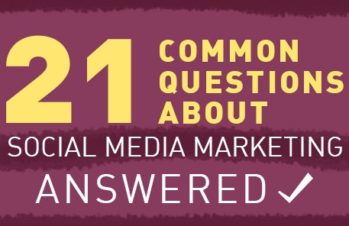Just getting started with B2B social media marketing?
Then consider this your guide to taking your brand from zero to hero—social media style.
In this guide, we’ll cover:
- Why B2B brands need social media
- How to develop a strong brand voice for social
- Creating your social media strategy
- The platform you definitely need to be using
- Tools that can help you execute your strategy
Let’s jump in!
Why do brands need B2B social media?
B2B brands everywhere are investing more resources in social media. Why?
Because social media is critical for B2B brands that want to:
- Boost their reputation
- Increase their sales
- Earn trust
- Increase their market share
- Retain customers
- Increase customer loyalty
Let’s take a look at how social media accomplishes these things and more for B2B brands.
Social media is where your customers are
Customer expectations for B2B have changed. Whereas just a few years ago, a B2B brand could get away with having only a website and maybe a LinkedIn company page, today your buyers want to see you on at least one or two platforms.
Why? Because that’s where they are. It’s where they’re getting industry news, finding thought leadership pieces, getting familiar with industry frontrunners, and even initiating contact with sales.
It’s also where they’re spending much of the exploration and evaluation phases of the B2B customer journey, searching for relevant content, looking at how you handle customer service, reading reviews, and more.
Take a look at these stats:
- 90% of consumers will buy from a brand they follow on social media (Sprout Social)
- 38% of customers prefer social media over other channels for resolving customer service issues, vs. 42% who prefer phone and 20% who prefer email (Statista)
- 78% of customers believe that social media is the fastest and most direct way to connect with a brand (Sprout Social)
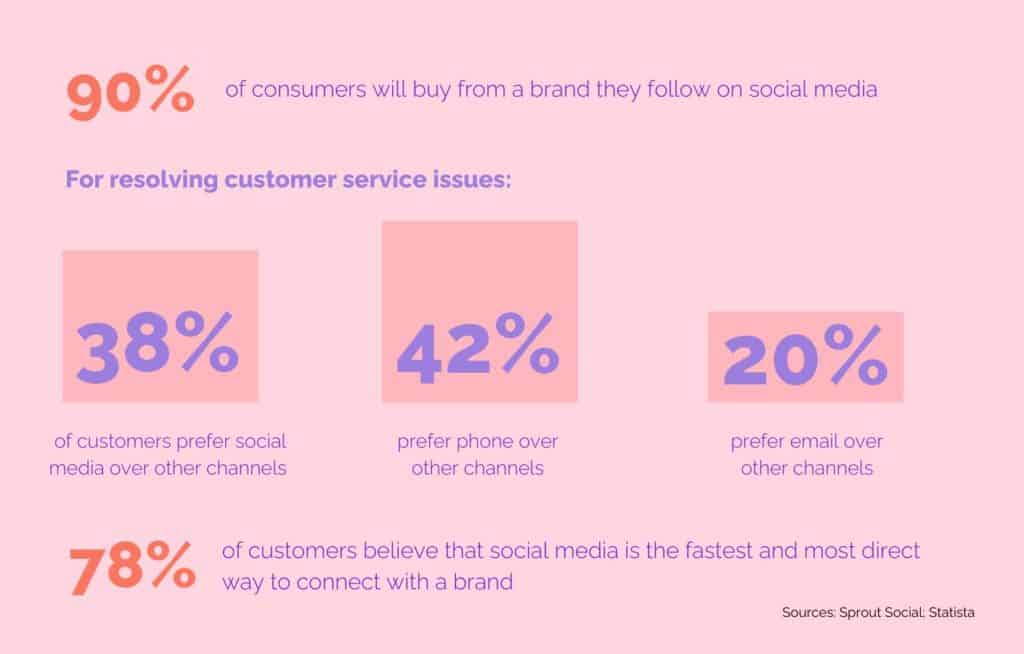
These consumers are your buyers. They’re majority Millennial, digital-savvy, and used to doing everything online. If they can’t find you on social, then they’re likely to pass right over you and move on to your competitors.
The simple truth these days is that brands that aren’t active on social look stagnant.
Whether it’s Instagram, Facebook, LinkedIn, Twitter, TikTok, or Clubhouse, find at least one platform that will work for you—make sure it’s the one that your customers use the most—and invest the time and resources necessary to develop a robust and engaging presence. This will go a long way toward boosting your reputation and earning trust online.
Related read: What’s Clubhouse? Everything You Need to Know About the New Platform
B2B social media marketing drives traffic to your website
Even if you’re not ready to start selling via social media, social is an important way to increase your site traffic and direct users to specific pages.
Landing pages, content downloads, free demo sign-ups—social is key in getting users to the places you want them to be.
Paid ads, whether Google ads or social ads, also perform this function, but users are growing ever more distrustful of advertising (74% of consumers think they see too many social ads, according to Survey Monkey).
This means that you simply can’t rely on ads alone and that social media has to play an even larger role in directing people to the right places.
By delivering value through information or entertainment, in a format that your buyers are already familiar with and using regularly, your B2B social media posts can be a much more effective way to increase traffic where it matters the most.
This, in turn, can lead to increased sales and an increase in new customers.
B2B buyers are more interested in self-service now than pre-pandemic
According to a McKinsey study, a full 97% of B2B buyers said they’d be comfortable using a fully digital, self-service model to make a B2B purchase, with most of that group comfortable spending $50k or more.
How does social media play into this?
Chatbots, for one—social chatbots, like the type brands can employ on Facebook, are one way to offer digital self-service.
Social media posts can also direct users to your self-service channels if they’re housed on an app or on your website. From text-based knowledge bases to video channels to customer preference databases, B2B buyers want to be able to access your resources on their own without needing to go through a salesperson or representative.
Social can amplify your B2B PR results
Finally, social media is an ideal platform for amplifying your B2B PR placements.
Many brands, and even B2B PR agencies, overlook this critical step. Once press has been achieved, they stop their efforts.
However, if you’re not amplifying your PR coverage by sharing it, repurposing it, and using it to support further PR efforts, you’re only getting a small percentage of the benefits that you could be.
While it’s true that the outlets you’ve been covered in will share the article, podcast, etc., you also need to be sharing it on your social channels. This will not only increase your press’s reach and get more eyes on it—it will also show the outlet that you appreciate the coverage and want it to be successful.
Social media is just as important for B2B brands as it is for B2C, as it builds trust, boosts your reputation, and can help you increase sales and share of voice in your industry.
Now that you know why social media is so important for your B2B brand, let’s move on to the next step: creating a strong brand voice.
How to develop a strong brand voice on social media
Your social media posts say a lot about your brand. But are they saying the right thing?
Because having a unified social media strategy is relatively time-consuming, many businesses have found themselves creating hasty profiles on three or four social media platforms, and posting what they can when they can—sometimes, simply just to maintain a presence on the channel.
While this is a fairly common situation, even among large B2B enterprises with lots of resources, it’s hardly ideal. The problem is that you’re not telling a unified story. You’re not speaking with a defined, recognizable brand voice. And that means that you’re missing out on a major opportunity to connect with your customers.
How do you go from having a haphazard social media presence to one that clearly identifies what your brand is all about? The key is developing your brand voice. Follow these five steps to get started.
1. Delve into your company’s culture.
Your brand voice is really an expression of your company culture, so a good place to start is to spend some time defining that culture. Is your company youthful and on-trend, like PopSugar? Or is it established and traditional, like Farmers Insurance Co.? Do you embrace risk, or avoid it? Is the culture lively, academic, warm, intellectual…you get the picture.
Once you’ve come up with a few adjectives to describe your general company culture, you’ve got a basic blueprint for your brand’s voice – a persona. But a basic blueprint isn’t quite enough. You want to be able to fill in the details, too.
To do that, start thinking about how you and your colleagues talk about your brand. How do you talk about it with each other? How do you talk about it with your clients? Are there specific topics that are important to your brand’s mission?
The answers to all of these questions will come into play as you develop your brand voice.
Example:
Dove Beauty Care is one of the greatest examples of how a brand can develop an authentic and important social media voice. If you’re not familiar with Dove and its social mission, all you have to do is take a look at their Twitter profile.
With just a single glance, you can tell what Dove is about: women, girls, beauty, and self-esteem. As you read through their tweets, you see posts on topics like body-shaming, negativity online, and how to talk to your daughter about self-esteem.
Dove’s brand voice, we see, is empowering, uplifting, and inspirational. The company has honed this voice to perfection, and it’s kept up along all its social media channels.
That’s not to say that you need to have an explicit social message the way that Dove does, because that’s not right for every company. However, your brand voice does need to go deeper than your product or service – it needs to express what your company is all about.
2. Establish your tone (or tones) by identifying your customers.
Once you’ve gotten a handle on your brand’s voice by looking inward, to your company, it’s time to develop your tone. To do that, you have to start looking outward.
Tone is, in essence, a subset of voice. While you have one brand voice, you can have several different tones that you use for different audiences or different situations.
Your customer personas will give you some guidance here. If you’re a large enterprise with many products aimed at different types of consumers – think Johnson & Johnson, which makes both medical devices and consumer baby products, for example – then you may have separate social media profiles for each product group, each with its own tone.
Take a look here at the Johnson’s Baby Twitter account, versus the corporate Johnson & Johnson (@JNJNews) Twitter account:
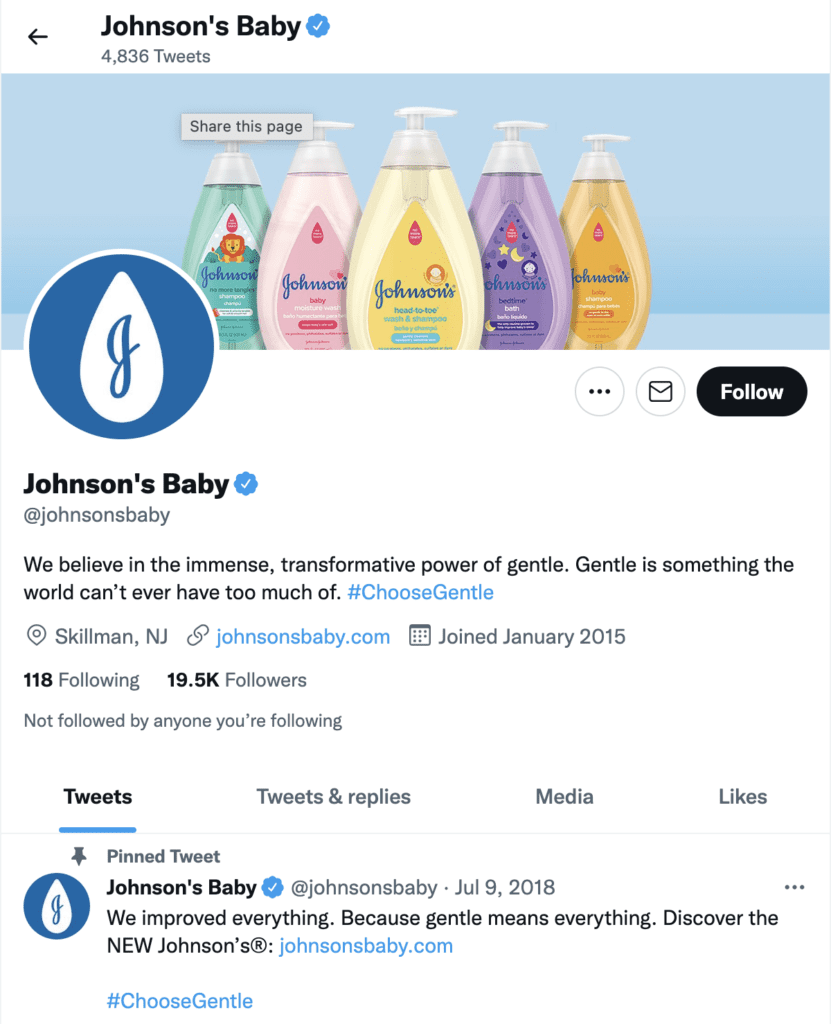
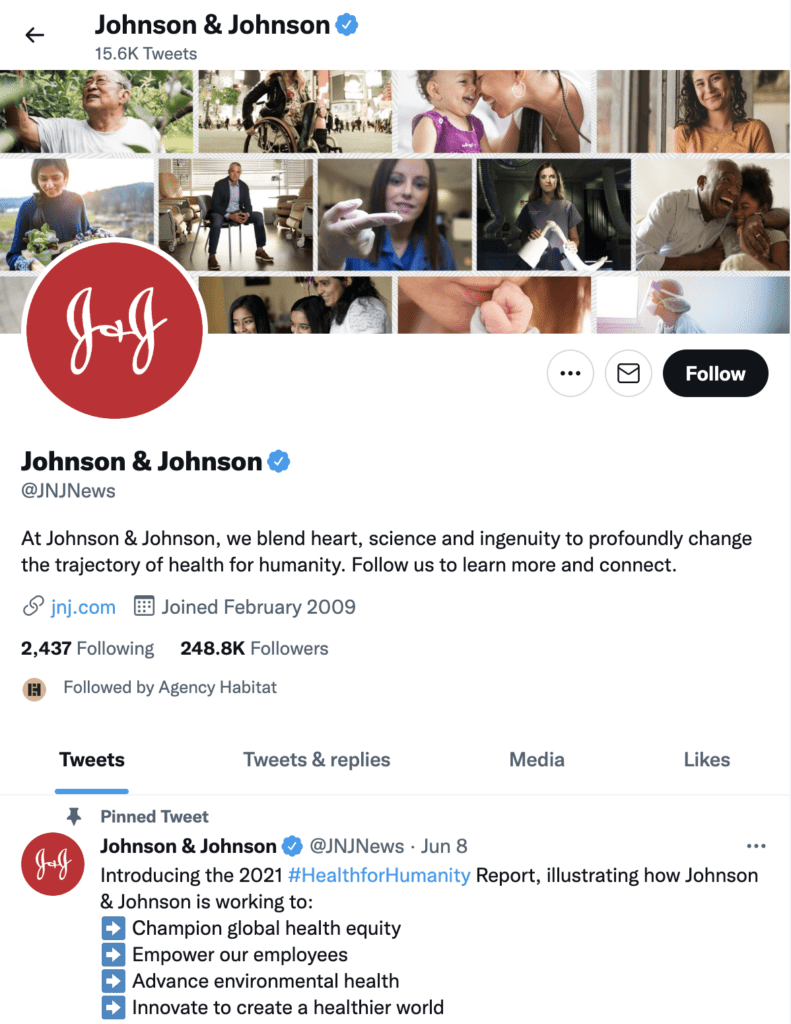
Each profile offers different types of information in a different tone – Johnson’s Baby is more personal, while Johnson & Johnson is rather formal, focused more on facts and figures. But both convey a consistent brand voice, which is responsible, knowledgeable, and caring.
Here’s a great graphic by Stephanie Schwab of Social Media Explorer that explains how tone plays into your brand voice.
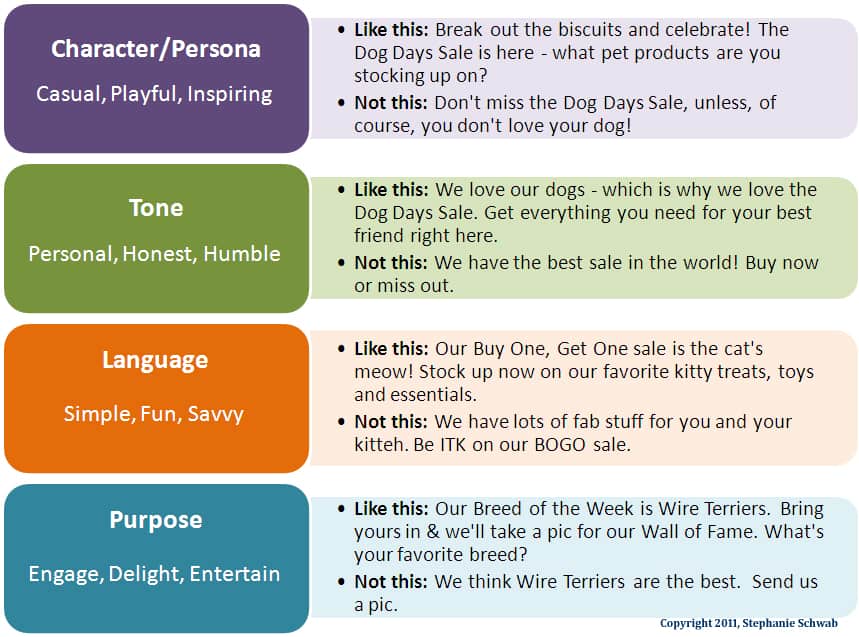
Just as the tone is an element of brand voice, so too are your persona (as mentioned earlier), language, and purpose. Language means, simply enough, the words you choose to speak to your customers, while Purpose refers to why you’re speaking to them at all. That could be to educate them on a specific product or topic, to engage them in a discussion of a particular issue, to entertain them with silly GIFs every Friday, etc.
When you’re dealing with multiple social media profiles or multiple customer groups, your tone and purpose may change; however, in general, your persona and language will stay roughly the same.
3. Cultivate authenticity.
No matter what your brand voice is like, it’s got to be authentic if it’s going to be effective. Social media is about conversing and engaging with your supporters, not disseminating product specs (although it can be used for that as well if done sparingly and carefully).
Having a clearly defined brand voice will go a long way toward helping you achieve this authenticity. Why? Because when the people who are posting for your brand know what that voice is, they’re freer to be themselves – within those specific guidelines, of course.
4. Think before you post.
This goes without saying, but it still bears repeating. It’s important to have a consistent presence on social media, yes – but you don’t want to post simply for the sake of posting. Doing this makes it more likely that you’ll post something that’s out of sync with your brand voice. And trust us: your followers will notice.
A good rule of thumb when you post as your brand is to ask yourself these two questions:
- Does this offer value to my followers? (Remember, entertainment is valuable, too – a post doesn’t always have to convey information in order to be of value.)
- Does this fit my brand voice?
5. Get personal.
If you want to make the jump from a great brand voice to a truly outstanding one, then get personal with your fans and followers.
One of the best things about social media is how easy it makes connecting with others, no matter who or where they are. Take advantage of this! Talk to your supporters one-on-one. Thank a fan for saying something nice about your brand. Address complaints by apologizing directly to the person who’s complaining.
Getting personal goes hand-in-hand with cultivating authenticity and will go a long way toward making your brand feel more like a person and less like an entity that just wants to sell you stuff.
And this is the prime advantage of social media.
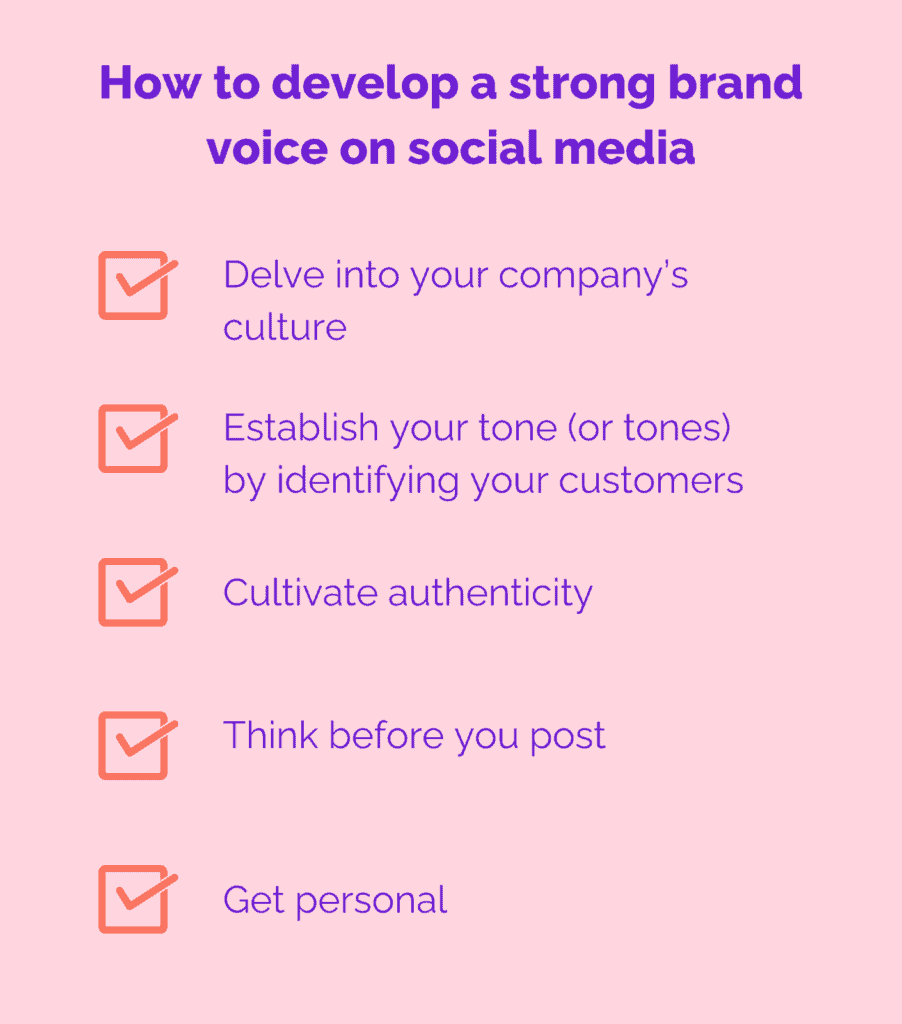
Developing your B2B social media strategy
For B2B brands, social posts should fall into a mix of the following categories:
- Owned content—blog posts, reports, ebooks, and other resources from your company
- “Behind-the-scenes” posts featuring employees, highlighting workplace culture, etc.
- Posts on trends, resources from thought leaders, and other industry information
Now that you have a general idea of the categories your posts should fall into, let’s move on to the step-by-step method for creating your strategy.
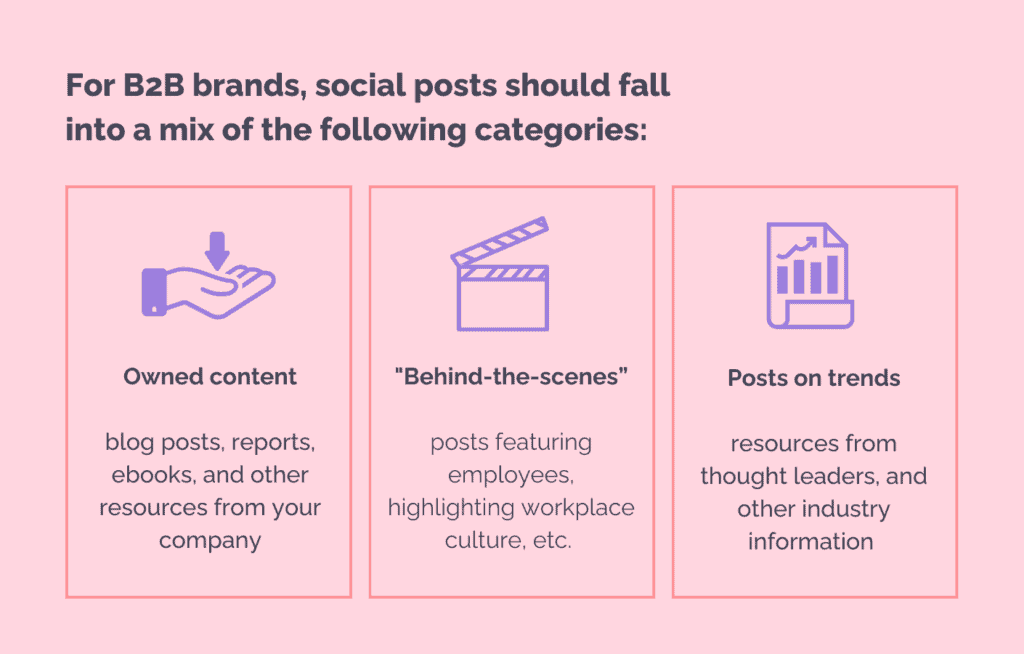
1. Clarify your goals.
What is it exactly that you’re trying to accomplish with your presence on social media? To drive awareness? Increase website traffic? Improve conversion rates? You won’t be able to create a useful game plan unless you know what it is you’re trying to do—simply throwing random content up on a blog or Twitter feed without a specific purpose in mind will not give you good results.
2. Define your audience.
Who is your ideal customer?
Defining your audience is crucial to your social media efforts. Your audience determines not only where you spend your time marketing, but also the type of content you will be providing, as well.
Remember that nowadays, B2B buyers are not only Boomers, but Millennials and even Gen Z. The types of content that these generations consumer are extremely different, so you’ll need to create content that can work for any and all of these groups (unless you’re able to uncover more about whom you’re marketing to, in which case you’ll want to focus heavily on that one audience).
3. Consider your resources.
Be realistic. If you’ll be implementing a social strategy on your own, keep your time limitations in mind as you plan. If, however, you have an entire marketing department at your disposal, take full advantage of it!
4. Analyze your competition.
Before you jump in headfirst, take some time to see what sort of online marketing your competitors are doing. Check out their strengths and weaknesses, and then use that information to craft your own unique strategy that fills in the holes they’ve left wide open. (Some of the tools included below can be very helpful in conducting this social listening research.)
5. Determine tone and frequency.
You can’t just write a blog “every once in a while,” or it’ll never get done. Plan in advance to write two blog posts a week, every Monday and Wednesday, or to post three Facebook updates per week, or to contribute to two LinkedIn discussions each week.
You’ll also need to decide what your official voice or tone will be in all these posts. Remember that you have options, even though you’re in B2B. It doesn’t have to be formal and businesslike. Conversational will almost certainly perform better with any audience, and you can also be funny, if that fits your brand and comes naturally.
Whatever you choose, make sure that it’s a tone that will appeal to your audience.
6. Identify core topics.
Decide in advance what topics you’ll write or post about, so that you’re not faced with the challenge of coming up with new material out of the blue each day. One option is to choose a day each week to post in a specific category—for example, Tuesday could be industry trends day, or Friday could be workplace culture day.
Planning out an editorial calendar for the month or at least two weeks at a time is recommended.
7. Engage your audience.
Now that you’ve completed the first six steps, you’re ready to get started! Share that content, but don’t stop there. Be sure to engage your audience in conversations, to build those relationships.
8. Use analytics.
Finally, check your stats frequently to see what’s working and what isn’t. Analyze your performance based on the goals you set out in Step One, and then make changes as necessary.
Each platform has its own analytics you can access, though Google Analytics will be of huge help as well. These reports can show you where your traffic is coming from, so if you see a huge increase or decrease in traffic coming from, say, Facebook, one week, you’ll want to go back and see what you were doing during that time that could have had that effect.
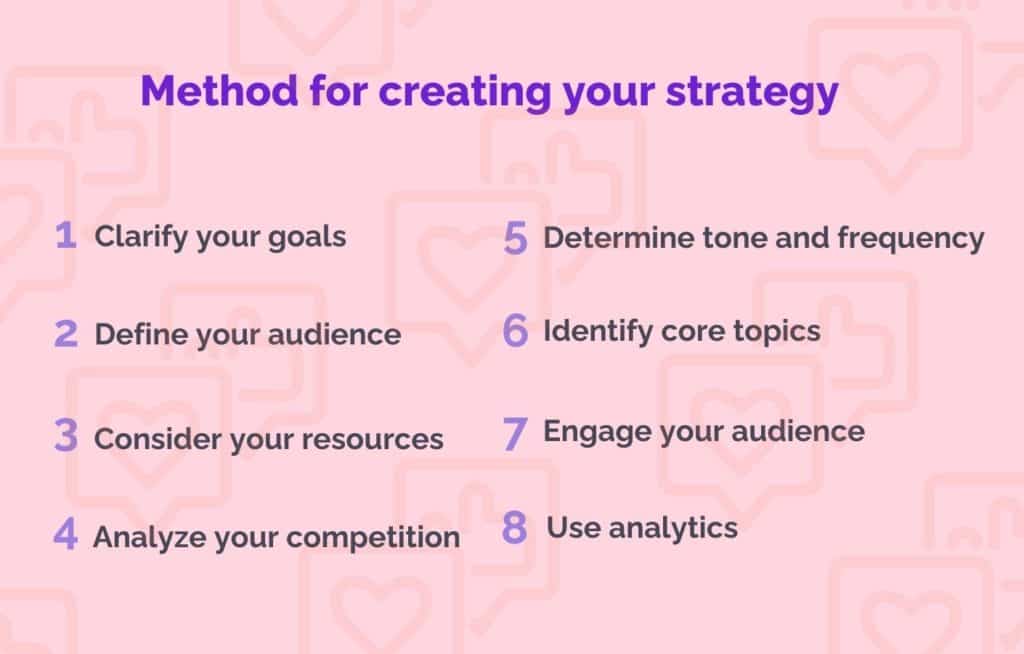
The social platform every B2B company should be using…
…is LinkedIn. Here’s why.
LinkedIn was already a major player in the B2B world pre-pandemic, and with the upheaval that came in 2020—including the huge increase in all-digital B2B selling and buying—LinkedIn’s role has only gotten larger.
LinkedIn’s own statistics bear this out.
When it comes to usage, LinkedIn’s platform has 61 million “senior-level influencers”—people who influence business decisions at their organizations. In addition, 4 out of 5 users on LinkedIn drive business decisions in some fashion, and 33% of B2B decision-makers are using the platform to research their purchase decisions.
This is an audience you can’t afford to overlook.
When it comes to what you should be sharing on LinkedIn, think thought leadership content, insightful commentary on news stories, industry issues, or current events, and of course, the content your brand is creating. Live streaming on LinkedIn is also a great way to connect with potential customers, as live streams on the platform receive 7x more reactions and 24x more comments than regular video posts.
What tools can help you manage B2B social media?
The scope of B2B social media marketing is broad and multifaceted. From tracking one’s performance to designing graphics and writing social copy, social media marketing requires a great deal of creative and systematic thought.
The good news: there are a ton of social media marketing tools at your disposal.
The top 13 B2B social media marketing tools we recommend are:
- SharpSpring
- Hootsuite
- Sprout Social
- Buffer
- Hubspot’s Social Inbox Tool
- Zoho Special
- SEMrush
- Agorapulse
- Sendible
- SocialPilot
- Kicksta
- Marketing Video Builder
- Falcon
Let’s dive in and explore each tool:
SharpSpring
Pricing: $550, $850, $1250 per month, and agency and enterprise pricing
If you’re looking for a complete sales and marketing platform with robust social media tools, look no further than SharpSpring.
You’ll get everything you expect from a social media management solution.
- Easily import and organize images, copy, and hashtags into a content calendar for your company (and your clients)
- Post immediately or schedule ahead to automatically post to an unlimited number of unique social media accounts on Facebook, Twitter, and LinkedIn
- Monitor engagement and growth
But SharpSpring Social goes beyond scheduling, publishing, and monitoring. You also gain access to powerful social listening and conversion tools you can only get from a fully integrated CRM marketing automation platform.
In order to make the most of your social management platform, you’ll want to identify hot leads and immediately start marketing directly to them. SharpSpring makes this easy by giving you access to trigger automation based on activity on social media—add those hot leads to a series of relevant emails or simply notify your sales team when it’s time to engage.
If you’re looking for a platform with top-tier analytics and the ability to generate reports that clearly demonstrate the true value of B2B social media marketing, look no further than SharpSpring Social. You’ll wow your CFO.
Hootsuite
Pricing: Free plan, $29, $129, $599 per month, and enterprise pricing (with a 30-day free trial)
Hootsuite is a one-stop shop, allowing users to manage all social media accounts on one platform. Hootsuite has over 15 million users, many of which belong to Fortune 1000 companies.
In the words of their chief marketing officer, Penny Wilson, “What was once the focus of a small number of enthusiasts inside an organization, today social media is at the heart of the digital strategy of the largest and most successful businesses. Hootsuite makes social media approachable for all businesses, including those in regulated industries, government, or higher education. Every day, we see companies use our platform in unique, innovative ways to engage with their customers.”
Sprout Social
Pricing: $99, $149, and $249 per user per month (with a 30-day free trial)
Comparable to Hootsuite, Sprout Social offers multiple resources within a single platform, including post scheduling, monitoring, and reporting.
As Alfred Lua notes, Sprout Social “is one of the few social media management tools that provides customer relationship management features.” This benefit allows Sprout Social users to look at their customer base holistically.
Their reports are excellent for teams that don’t want to spend much time formatting and reconfiguring data, as they come in a format suitable to present to both department heads and clients.
Buffer
Pricing: Forever free plan, $15, $99, $199, and $399 per month (with a 14-day free trial)
Buffer is often commended for its intuitive design and responsive customer service. It offers products for publishing, engagement, analytics, and team collaboration.”
One blogger remarks, “Buffer as a company is all about a set of principles that value diverse workforces, flexible structures, well-balanced employees, and radical transparency…Considering the Buffer product is about interacting with people—we’d say things like diversity, flexibility and honesty certainly do make for more productive social relations.”
Hubspot Social Inbox Tool
Pricing: Component of Hubspot’s all-in-one marketing software, starting at $1,120 per month.
Hubspot’s Social Inbox Tool is primarily used to manage one’s social media engagements.
According to the HubSpot Knowledge Base, Inbox allows users to “identify interaction-generating content, respond to social conversations, gather intelligence about new followers, and see social stream matches.”
Hubspot’s Social Inbox Tool can be integrated into a company’s existing CRM, making it easy to determine the number of leads and customers you’re bringing in from your B2B social media marketing efforts.
Zoho Special
Pricing: Standard at $10 per month or billed annually, Professional at $25 per month or billed annually, Agency at $200 per month or billed annually, Agency Plus at $300 per month or billed annually
In addition to offering an all-in-one platform setup, Zoho Social includes a social calendar feature. Zoho also has the ability to track target keywords across one’s accounts.
TechRadar notes Zoho’s Agency and Agency Plus package includes benefits “specifically for the needs of marketing agencies, which allows for brand and communications management for client lists, while also allowing for white labeling.”
SEMrush
Pricing: $99.95, $199.95, $399.95
SEMRush is an SEO tool used for keyword research, optimizing Google Ad campaigns, performing competitor analysis, and social media account management.
Specifically, SEMrush can perform scheduling and image editing. It also includes a UTM-builder and can be used to manage ads on various social media platforms.
Ultimately, SEMrush’s strengths lie in its ability to combine social media management with a company’s overall B2B SEO strategy.
Agorapulse
Pricing: $49, $99, $199, and $299 per month (with a 14-day free trial)
Agorapulse is a great resource for agencies, as well as any business with multiple clients.
Scheduling posts on Agorapulse is easy and flexible, allowing users to effortlessly queue and reschedule when necessary.
One can also build a CRM database in Agorapulse for customer tracking purposes.
Sendible
Pricing: $29, $99, $199, $299 per month, and enterprise pricing (with a 30-day free trial)
Similar to Agorapulse, Sendible is ideal for agencies or organizations with several clients.
Unique features include the ability to personalize one’s dashboard, integrate with the graphics-focused app Canva, and download royalty-free images.
SocialPilot
In addition to providing users an easy way to manage their social media accounts, Social Pilot also has a unique feature that curates relevant content for your brand (or client’s brand) from a variety of industries. This can be a helpful tool for your social team as they’re creating content.
For more information, you can check out their blog.
Kicksta
Kicksta is primarily used to grow one’s Instagram following.
After allowing Kicksta to access your company’s social media account, the tool will “like” approximately 30,000 photos per month on targeted accounts. After receiving the likes, these accounts reciprocate by following your brand.
Ryan Beltran, CEO of Original Grain, remarks, “Kicksta helps introduce new audiences to our brand while providing consistent organic Instagram growth.”
Marketing Video Builder
Pricing: Free or $33/month.
Created by Animoto, Marketing Video Builder helps users create their own “professional-tier” videos.
Videos on social media receive 1200% more shares than text and images combined, so this tool is well worth considering.
Marketing Video Builder offers pre-built storyboards to help inspire you. This tool also has integrations with LinkedIn, Twitter, YouTube, Facebook, and Getty Images.
Falcon
Pricing: $129 per month
Falcon is a social media management platform where users can create posts using a “collaborative content calendar.” Falcon also provides analytics, customer experience management, and even a landing page builder.
Falcon can be integrated with Microsoft and Salesforce, and when used with Hubspot, it can also help segment your audiences.
Social media supports a more personalized customer experience
Personalization is what both B2C and B2B customers are demanding, and social media helps your brand deliver in multiple ways.
For one thing, social media offers customers a more human view of your brand, especially if you’ve been diligent about developing your brand voice.
Related read: 5 Steps to Developing an Outstanding Brand Voice on Social Media
B2B buyers, just like B2C consumers, expect to be able to connect directly with the brands they’re working with. That means getting a personal, human response when they ask a question or post about an experience they had with your brand.
Customer retention starts with connecting with them on this level, anticipating their needs and responding to them quickly and empathetically.
But while your customers benefit from your B2B brand’s social media presence, your company stands to benefit even more.
Interacting with your customers on social platforms lets you get a clearer picture of what they value and what they engage with.
When you share content on social, for example, the number of engagements can show you the general degree of interest your customers and potential customers have in that type of content. You can even ask outright for their feedback and get their opinions firsthand (otherwise known as collecting zero-party data).
The data you gather via social media analytics can also help you to further hone your content strategy, social strategy, ad strategy, even product and service offerings. Just as social media allows your customers to see who’s behind your brand, it also allows you to see your customers for who they are online—their interests, needs, desires, and more.
Need some help getting started? Get in touch with our social media experts today!





